Alterations of Carbonate Mineral Matrix and Kerogen Micro-Structure in Domanik Organic-Rich Shale during Anhydrous Pyrolysis
Abstract
:1. Introduction
2. Materials and Methods
2.1. Materials
2.2. Methods
2.2.1. Experiment Design
2.2.2. X-ray Diffractometry
2.2.3. Thin Section Analysis
2.2.4. Broad Ion Beam Scanning Electron Microscopy
2.2.5. Energy-Dispersive X-ray Spectroscopy
2.2.6. Programmed Pyrolysis
2.2.7. Computed Micro Tomography
3. Results
3.1. Mineral Matrix Alteration
3.2. Organic Matter Alterations
3.3. Porous Media Alterations
4. Discussion
4.1. The Nature of Structural Alterations during Thermal Carbonate Mineral Matrix Decomposition
- From CaO via interaction with SO2 and CO according to Equation (3), where SO2 can be generated via the reaction between pyrrhotite and oxygen contained in organic matter;
- From calcite, calcium oxide, or hydroxide in contact with H2S gas via the following reactions suggested by Kim Hoong et al. [54]:orCaCO3 + H2S → CaS + H2O + CO2,orCaO + H2S → CaS + H2O,where H2S can be generated from organic matter or from the interaction of organic matter and products of pyrite decomposition.Ca(OH)2 + H2S → CaS + 2 H2O,
4.2. Kerogen Microstructural Transformation
5. Conclusions
- High-temperature treatment induced a significant alteration of the carbonate mineral matrix in Domanik Formation shale. The alteration included the decomposition of carbonates and the formation of new minerals, such as lime, periclase, portlandite, and oldhamite;
- The decomposition of carbonates in a shale multicomponent medium is more complicated than in pure carbonates: CaS was formed in the presence of sulfur-containing components such as pyrite and OM, whereas Ca(OH)2 was formed in the presence of water;
- The void space of Domanik Formation shale evolved through the temperature treatment. At the temperature of 350 °C, fractures started to appear at the edges between components, whereas, at 450 °C fractures appeared within the organic matter. Micropores in the carbonate mineral matrix formed after carbonate thermal decomposition at T = 800 °C. The bulk porosity increased from almost zero in the initial state to 6.7% at T = 800 °C;
- The microstructure of organic matter was significantly altered during the treatment of Domanik Formation rocks. Microfractures formed in the OM at T = 400 °C, while shrinkage and compaction occurred in the temperature range of 350–600 °C by approximately 32%.
Author Contributions
Funding
Data Availability Statement
Acknowledgments
Conflicts of Interest
References
- Shmaefsky, B. The Past, Present, and Future of Earth’s Natural Resources (November 2018): The Future of Earth’s Natural Resources. Available online: https://ala-choice.libguides.com/c.php?g=879515&p=6319563 (accessed on 10 June 2022).
- International Energy Agency (IEA). Oil 2021, Analysis and Forecast to 2026. 2021. Available online: https://iea.blob.core.windows.net/assets/1fa45234-bac5-4d89-a532-768960f99d07/Oil_2021-PDF.pdf (accessed on 10 June 2022).
- Cozzi, L.; Gould, T.; Bouckart, S.; Crow, D.; Kim, T.Y.; Mcglade, C.; Olejarnik, P.; Wanner, B.; Wetzel, D. World Energy Outlook 2020; IEA: Paris, France, 2020; Volume 2050, pp. 1–461. [Google Scholar]
- The Organization of the Petroleum Exporting Countries (OPEC). OPEC World Oil Outlook (WOO). 2020. Available online: https://www.opec.org/opec_web/en/press_room/6147.htm (accessed on 10 June 2022).
- Tsvetkov, L.D.; Tsvetkova, N.L. Shale Oil of Russia. Sci. Tech. Collect. News Gas Sci. 2013, 16, 219–230. [Google Scholar]
- Stupakova, A.V.; Kalmykov, G.A.; Fadeeva, N.P.; Bogomolov, A.K.; Kiryukhina, T.A.; Korobova, N.I.; Maltsev, V.V.; Pronina, N.V.; Sautkin, R.S.; Suslova, A.A.; et al. On the Estimation of Shale-Oil Resources and Reserves. Moscow Univ. Geol. Bull. 2015, 70, 183–190. [Google Scholar] [CrossRef]
- U.S. Energy Information Administration (EIA). World Shale Resource Assessments. 2015. Available online: https://www.eia.gov/analysis/studies/worldshalegas/. (accessed on 10 June 2022).
- Rezaee, R. (Ed.) Fundamentals of Gas Shale Reservoirs; John Wiley and Sons: Hoboken, NJ, USA, 2015. [Google Scholar]
- Palacas, J.G. PD 1(3) Carbonate Rocks as Sources of Petroleum: Geological and Chemical Characteristics and Oil-Source Correlations. In Proceedings of the 11th World Petroleum Congress, London, UK, 28 August 1983. [Google Scholar]
- Karamov, T.; Mukhametdinova, A.; Bogdanovich, N.; Plotnikov, V.; Khakimova, Z. Pore Structure Investigation of Upper Devonian Organic-Rich Shales within the Verkhnekamsk Depression. In Proceedings of the International Multidisciplinary Scientific GeoConference: SGEM, Varna, Bulgaria, 30 June–6 July 2019; Volume 19, pp. 1045–1051. [Google Scholar]
- Zou, C. Unconventional Petroleum Geology; Elsevier: Amsterdam, The Netherlands, 2017; p. 500. [Google Scholar]
- Ryan, R.C.; Fowler, T.D.; Beer, G.L.; Nair, V. Shell’s In Situ Conversion Process−From Laboratory to Field Pilots. In Oil Shale: A Solution to the Liquid Fuel Dilemma; American Chemical Society: Washington, DC, USA, 2010; pp. 161–183. [Google Scholar] [CrossRef]
- Hazra, K.G.; Lee, K.J.; Economides, C.E.; Moridis, G. Comparison of Heating Methods for In-situ Oil Shale Extraction. In Proceedings of the IOR 2013-17th European Symposium on Improved Oil Recovery, St. Petersburg, Russia, 16–18 April 2013. [Google Scholar] [CrossRef] [Green Version]
- Kangac, Z.; Zhao, Y.; Yang, D. Review of Oil Shale In-situ Conversion Technology. Appl. Energy 2020, 269, 115121. [Google Scholar] [CrossRef]
- Kar, T.; Hascakir, B. In-situ kerogen extraction via combustion and pyrolysis. J. Pet. Sci. Eng. 2017, 154, 502–512. [Google Scholar] [CrossRef]
- Lee, K.; Moridis, G.J.; Ehlig-Economides, C.A. A Comprehensive Simulation Model of Kerogen Pyrolysis for the In-situ Upgrading of Oil Shales. SPE J. 2016, 21, 1612–1630. [Google Scholar] [CrossRef] [Green Version]
- Kobchenko, M.; Panahi, H.; Renard, F.; Dysthe, D.K.; Malthe-Sørenssen, A.; Mazzini, A.; Scheibert, J.; Jamtveit, B.; Meakin, P. 4D Imaging of Fracturing in Organic-Rich Shales During Heating. J. Geophys. Res. Solid Earth 2011, 116, B12201. [Google Scholar] [CrossRef]
- Saif, T.; Lin, Q.; Singh, K.; Bijeljic, B.; Blunt, M.J. Dynamic Imaging of Oil Shale Pyrolysis using Synchrotron X-ray Micro-tomography: Dynamic Imaging of Oil Shale Pyrolysis. Geophys. Res. Lett. 2016, 43, 6799–6807. [Google Scholar] [CrossRef] [Green Version]
- Bai, F.; Sun, Y.; Liu, Y.; Guo, M. Evaluation of the porous structure of Huadian oil shale during pyrolysis using multiple approaches. Fuel 2017, 187, 1–8. [Google Scholar] [CrossRef]
- Geng, Y.; Liang, W.; Liu, J.; Cao, M.; Kang, Z. Evolution of Pore and Fracture Structure of Oil Shale under High Temperature and High Pressure. Energy Fuels 2017, 31, 10404–10413. [Google Scholar] [CrossRef]
- Kim, T.W.; Ross, C.M.; Guan, K.; Burnham, A.K.; Kovscek, A.R. Permeability and Porosity Evolution of Organic Rich Shales as a Result of Heating. In Proceedings of the SPE Western Regional Meeting, San Jose, CA, USA, 23 April 2019. [Google Scholar]
- Mukhametdinova, A.; Mikhailova, P.; Kozlova, E.; Karamov, T.; Baluev, A.; Cheremisin, A. Effect of Thermal Exposure on Oil Shale Saturation and Reservoir Properties. Appl. Sci. 2020, 10, 9065. [Google Scholar] [CrossRef]
- Gafurova, D.R.; Korost, D.V.; Kozlova, E.V.; Kalmykov, A.G.; Kalmykov, G.A. Changes in The Void Space of Various Lithotypes of Kerogen-Saturated Rocks of The Domanic Formation at Different Heating Rates. Georesources 2017, 19, 255–263. [Google Scholar] [CrossRef]
- Gafurova, D.R.; Kalmykov, A.; Korost, D.; Kalmykov, G. Macropores Generation in the Domanic Formation Shales: Insights from Pyrolysis Experiments. Fuel 2021, 289, 119933. [Google Scholar] [CrossRef]
- Kovaleva, L.; Zinnatullin, R.; Musin, A.; Kireev, V.; Karamov, T.; Spasennykh, M. Investigation of Source Rock Heating and Structural Changes in the Electromagnetic Fields Using Experimental and Mathematical Modeling. Minerals 2021, 11, 991. [Google Scholar] [CrossRef]
- Nasyrova, Z.R.; Kayukova, G.P.; Shunina, E.N.; Islamova, G.G.; Batalin, G.A.; Morozova, E.V.; Vakhin, A.V.; Nurgaliev, D.K. Thermal Decomposition of Kerogen in High-Carbon Domanic Rock of the Romashkino Oilfield in Sub-and Supercritical Water. Energy Fuels 2022, 36, 3549–3562. [Google Scholar] [CrossRef]
- Rodriguez-Navarro, C.; Ruiz-Agudo, E.; Luque, A.; Rodriguez-Navarro, A.B.; Ortega-Huertas, M. Thermal Decomposition of Calcite:Mechanisms of Formation and Textural Evolution of CaO Nanocrystals. Am. Mineral. 2009, 94, 578–593. [Google Scholar] [CrossRef]
- Jukkola, E.E.; Denilauler, A.J.; Jensen, H.B.; Barnet, W.I.; Murphy, W.I.R. Thermal Decomposition Rates of Carbonates in Oil Shale. Ind. Eng. Chem. 1953, 45, 2711–2714. [Google Scholar] [CrossRef]
- Fortunatova, N.K.; Zayceva, E.L.; Bushueva, M.A.; Shvec-Teneta-Gutiy, A.G.; Baranova, A.V.; Kononova, L.I.; Rahimova, E.V.; Mikheeva, A.I.; Olenova, N.V.; Avdeeva, A.A. Unified Sub-Regional Stratigraphic Schematic of the Upper Devonian Sediments of the Volga-Ural Sub-Region; Explanatory Note; VNIGRI: Moscow, Russia, 2018; p. 63. (In Russian) [Google Scholar]
- Kiruhina, T.A.; Fadeeva, N.P.; Stupakova, A.V.; Poludetkina, E.N.; Sautkin, R.S. Domanic deposits of the Timan-Pechora and Volga-Ural Basins. Oil Gas Geol. 2013, 3, 76–87. [Google Scholar]
- Lianga, X.; Jina, Z.; Philippov, V.; Obryadchikov, O.; Zhong, D.; Liu, Q.; Uspensky, B.; Morozov, V. Sedimentary characteristics and evolution of Domanik facies from the Devonian–Carboniferous regression in the southern Volga-Ural Basin. Mar. Pet. Geol. 2020, 119, 104438. [Google Scholar] [CrossRef]
- Gabnasyrov, A.V.; Lyadova, N.A.; Putilov, I.S.; Solovyev, S.I. Domanik Shale Oil: Unlocking Potential. In Proceedings of the SPE Russian Petroleum Technology Conference and Exhibition, Moscow, Russia, 11 October 2016. [Google Scholar] [CrossRef]
- Fadeeva, N.P.; Kozlova, E.V.; Poludetkina, E.N.; Shardanova, T.A.; Pronina, N.V.; Stupakova, A.V.; Kalmykov, G.A.; Khomyak, A.N. The Hydrocarbon-Generation Potential of the Domanik Rocks in the Volga–Ural Petroliferous Basin. Mosc. Univ. Geol. Bull. 2016, 71, 41–49. [Google Scholar] [CrossRef]
- Bazhenova, T.K. Mixed rocks containing non-carbonate carbon. In Systematics and Classification of Sedimentary Rocks and Their Analogues; Nedra: St. Petersburg, Russia, 1998; pp. 265–269. [Google Scholar]
- Bushev, D.A.; Burdel’naya, N.S.; Valyaeva, O.V.; Derevesnikova, A.A. Geochemistry of Late Devonian Oils of the Timan-Pechora Basin. Russ. Geol. Geophys. 2017, 58, 332–342. [Google Scholar] [CrossRef]
- Prishchepa, O.M.; Averyanova, O.Y. The notion base and the paramount objects of unconventional raw hydrocarbons supply. Oil Gas J. (Online J.) 2013, 10, 1–11. Available online: http://oilgasjournal.ru/vol_10/prishchepa.html (accessed on 10 June 2022).
- Kiseleva, Y.A.; Zheglova, T.P.; Dakhnova, M.V.; Mozhegova, S.V.; Nazarova, E.S.; Nechitailo, G.S. The role of Domanik deposits in the formation of oil pools in the central areas of the Volga–Ural petroleum province (Buzuluk depression). Russ. Geol. Geophys. 2017, 58, 310–321. [Google Scholar] [CrossRef]
- Vashkevich, A.A.; Strizhnev, K.V.; Shashel, V.A.; Zakharova, O.A.; Kasyanenko, A.A.; Zagranovskaya, D.E.; Grebenkina, N.Y. Forecast of prospective areas for sediment type Domanic in the Volga-Ural oil and gas province (Russian). Neftyanoe Khozyaystvo-Oil Ind. 2018, 12, 14–17. [Google Scholar] [CrossRef]
- Kadurov, R.; Galiullin, B.; Statsenko, E.O. The porous space structure of Domanik shales in the East of Russian plate. In Proceedings of the 18th International Multidisciplinary Scientific GeoConference SGEM2018, Science and Technologies in Geology, Exploration and Mining, Albena, Bulgaria, 2–8 July 2018; Volume 18, pp. 907–914. [Google Scholar]
- Bogdanovich, N.; Kozlova, E.; Karamov, T. Lithological and Geochemical Heterogeneity of the Organo-Mineral Matrix in Carbonate-Rich Shales. Geosciences 2021, 11, 295. [Google Scholar] [CrossRef]
- Stoupakova, A.V.; Kalmykov, G.A.; Korobova, N.I.; Fadeeva, N.P.; Gatovskii, Y.A.; Suslova, A.A.; Sautkin, R.S.; Pronina, N.V.; Bolshakova, M.A.; Zavyalova, A.P.; et al. Oil-Domanic deposits of the Volga-Ural basin–types of section, formation conditions and prospects of oil and gas potential. Georesursy. Georesources 2017, 1, 112–124. [Google Scholar] [CrossRef]
- Sanei, H. Genesis of solid bitumen. Sci. Rep. 2020, 10, 15595. [Google Scholar] [CrossRef]
- Hart, B.S.; Steen, A.S. Programmed pyrolysis (Rock-Eval) data and shale paleoenvironmental analyses: A review. Interpretation 2015, 3, SH41–SH58. [Google Scholar] [CrossRef]
- Lopatin, N.V. Emets TP Piroliz V Neftegazovoy Geokhimii; Nauka: Moscow, Russia, 1987; p. 145. (In Russian) [Google Scholar]
- Mastalerz, M.; Schieber, J. Effect of ion milling on the perceived maturity of shale samples: Implications for organic petrography and SEM analysis. Int. J. Coal Geol. 2017, 183, 110–119. [Google Scholar] [CrossRef]
- Schneider, C.A.; Rasband, W.S.; Eliceiri, K.W. NIH Image to ImageJ: 25 years of image analysis. Nat. Methods 2012, 9, 671–675. [Google Scholar] [CrossRef]
- Shahraki, B.K.; Mehrabi, B.; Gholizadeh, K.; Mohammadinasab, M. Thermal behavior of calcite as an expansive agent. J. Min. Metall. Sect. B Metall. 2011, 47, 89–97. [Google Scholar] [CrossRef]
- Belousov, M.V.; Selivanov, E.N.; Gulyaeva, R.I.; Tyushnyakov, S.N.; Rakipov, D.F. Thermodynamics and Kinetics of the Thermal Dissociation of Dolomite. Russ. J. Non-Ferr. Met. 2016, 57, 180–186. [Google Scholar] [CrossRef]
- Cherkasov, A.V. Low-Energy Technology of Binder Compositions with Controlled Expansion Based on Magnesium-Containing Materials. Ph.D. Thesis, V.G. Technological University, Belgorod Oblast, Russia, 2006. [Google Scholar]
- Topor, N.D.; Ogorodova, L.P.; Melchakova, L.V. Thermal Analysis of Minerals and Inorganic Compounds; Nauka: Moscow, Russia, 1987. (In Russian) [Google Scholar]
- Haberle, C.W.; Garvie, L.A. Extraterrestrial formation of oldhamite and portlandite through thermal metamorphism of calcite in the Sutter’s Mill carbonaceous chondrite. Am. Mineral. J. Earth Planet. Mater. 2017, 102, 2415–2421. [Google Scholar] [CrossRef]
- Kruszewski, Ł. Oldhamite-periclase-portlandite-fluorite assemblage and coexisting minerals of burnt dump in Siemianowice Ślaskie-Dabrówka Wielka area (Upper Silesia, Poland)—Preliminary report. Mineral. Pol. 2006, 28, 118–120. [Google Scholar]
- Oh, J.S.; Wheelock, T.D. Reductive decomposition of calcium sulfate with carbon monoxide: Reaction mechanism. Ind. Eng. Chem. Res. 1990, 29, 544–550. [Google Scholar] [CrossRef] [Green Version]
- Ng, K.H.; Liew, S.C.; Zhang, S. Thermodynamic analysis of CaS production from various Ca-based precursors: A prequel to SO2 reduction mediated by CaS/CaSO4 redox agents. Process Saf. Environ. Prot. 2021, 147, 900–911. [Google Scholar] [CrossRef]
- Chen, H.K.; Li, B.Q.; Zhang, B.J. Transformation of sulfur during pyrolysis and hydropyrolysis of coal. Fuel 1998, 77, 487. [Google Scholar] [CrossRef]
- Yani, S.; Zhang, D. An experimental study into pyrite transformation during pyrolysis of Australian lignite samples. Fuel 2010, 89, 1700–1708. [Google Scholar] [CrossRef]
- Mozaffari, S.; Baird, Z.S.; Järvik, O. Sulfur in kukersite shale oil: Its distribution in shale oil fractions and the effect of gaseous environment. J. Therm. Anal. Calorim. 2022, 1, 1–10. [Google Scholar] [CrossRef]
- Hu, G.; Dam-Johansen, K.; Wedel, S.; Hansen, J.P. Decomposition and oxidation of pyrite. Prog. Energy Combust. Sci. 2006, 32, 295–314. [Google Scholar] [CrossRef]
- Calkins, W.H. Investigation of organic sulfur-containing structures in coal by flash pyrolysis experiments. Energy Fuels 1987, 1, 59–64. [Google Scholar] [CrossRef]
- Cleyle, P.J.; Caley, W.F.; Stewart, L.; Whiteway, S.G. Decomposition of pyrite and trapping of sulphur in a coal matrix during pyrolysis of coal. Fuel 1984, 63, 1579–1582. [Google Scholar] [CrossRef]
- Anthony, J.W.; Bideaux, R.A.; Bladh, K.W.; Nichols, M.C. (Eds.) Handbook of Mineralogy; Mineralogical Society of America: Chantilly, VA, USA; Available online: http://www.handbookofmineralogy.org/ (accessed on 10 June 2022).
- Justnes, H.; Escudero-Oñate, C.; Garmo, Ø.A.; Mengede, M. Transformation Kinetics of Burnt Lime in Freshwater and Sea Water. Materials 2020, 13, 4926. [Google Scholar] [CrossRef] [PubMed]
- Ramachandran, V.S.; Sereda, P.J.; Feldman, R.F. Mechanism of Hydration of Calcium Oxide. Nature 1964, 201, 288–289. [Google Scholar] [CrossRef]
- Vandenbroucke, M. Kerogen: From Types to Models of Chemical Structure. Oil Gas Sci. Technol. 2003, 58, 243–269. [Google Scholar] [CrossRef] [Green Version]
- Bousige, C.; Ghimbeu, C.M.; Vix-Guterl, C.; Pomerantz, A.E.; Suleimenova, A.; Vaughan, G.; Garbarino, G.; Feygenson, M.; Wildgruber, C.; Ulm, F.J.; et al. Realistic molecular model of kerogen’s nanostructure. Nat. Mater. 2016, 15, 576–582. [Google Scholar] [CrossRef] [PubMed]
- Budinava, T.; Huang, W.; Racheva, I.; Tsyntsarski, B.; Petrova, B.; Yardim, M.F. Investigation of Kerogen Transformation during Pyrolysis by Applying a Diamond Anvil Cell. Oil Shale 2014, 31, 121. [Google Scholar] [CrossRef] [Green Version]
- Alafnan, S. The Impact of Pore Structure on Kerogen Geomechanics. Geofluids 2021, 2021, 4093895. [Google Scholar] [CrossRef]
- Vasiliev, A.L.; Pichkur, E.B.; Mikhutkin, A.A.; Spasennikh, M.J.; Bogdanovich, N.N.; Balushkina, N.S.; Kalmikov, G.A. The study of pore space morphology in kerogen from Bazhenov formation. Oil Ind. J. 2015, 10, 28–31. [Google Scholar]
- Ko, L.T.; Loucks, R.G.; Zhang, T.; Ruppel, S.C.; Shao, D. Pore and pore network evolution of Upper Cretaceous Boquillas (Eagle Ford-equivalent) mudrocks: Results from gold tube pyrolysis experiments. AAPG Bull. 2016, 100, 1693–1722. [Google Scholar] [CrossRef]
- Liu, C.; Zheng, H.; Wang, D. Raman spectroscopic study of calcite III to aragonite transformation under high pressure and high temperature. High Press. Res. 2017, 37, 545–557. [Google Scholar] [CrossRef]
- Patil, K.; Jain, S.; Gandi, R.K.; Shankar, H.S. Calcium carbonate decomposition under external pressure pulsations. In Proceedings of the AIChE Annual Meeting, Conference Proceedings, Austin, TX, USA, 7–12 November 2004; pp. 3943–3962. [Google Scholar]
- Kazak, E.S.; Kazak, A.V. Experimental features of cation exchange capacity determination in organic-rich mudstones. J. Nat. Gas Sci. Eng. 2020, 83, 103456. [Google Scholar] [CrossRef]
- Kazak, E.S.; Kazak, A.V. A novel laboratory method for reliable water content determination of shale reservoir rocks. J. Pet. Sci. Eng. 2019, 183, 106301. [Google Scholar] [CrossRef]
- Kazak, E.S.; Kozlova, E.V.; Karamov, T.I.; Bogdanovich, N.N.; Chizhov, D.B. Connate water of the organocarbonate shale rocks of domanic deposits (Russian). Neftyanoe Khozyaystvo-Oil Ind. 2021, 2021, 84–89. [Google Scholar] [CrossRef]
- Cavelan, A.; Boussafir, M.; Le Milbeau, C.; Laggoun-Défarge, F. Impact of Oil-Prone Sedimentary Organic Matter Quality and Hydrocarbon Generation on Source Rock Porosity: Artificial Thermal Maturation Approach. ACS Omega 2020, 5, 14013–14029. [Google Scholar] [CrossRef] [PubMed]
- Sun, Y.H.; Bai, F.T.; Lü, X.S.; Li, Q.; Liu, Y.M.; Guo, M.Y.; Guo, W.; Liu, B.C. A Novel Energy-Efficient Pyrolysis Process: Self-pyrolysis of Oil Shale Triggered by Topochemical Heat in a Horizontal Fixed Bed. Sci. Rep. 2015, 5, 1–8. [Google Scholar] [CrossRef] [PubMed] [Green Version]
- Tovar, F.D.; Barrufet, M.A.; Schechter, D.S. Enhanced oil recovery in the wolfcamp shale by carbon dioxide or nitrogen injection: An experimental investigation. SPE J. 2021, 26, 515–537. [Google Scholar] [CrossRef]
- Sheng, J.J. Enhanced oil recovery in shale reservoirs by gas injection. J. Nat. Gas Sci. Eng. 2015, 22, 252–259. [Google Scholar] [CrossRef] [Green Version]
- Bauman, J.H.; Deo, M. Simulation of a conceptualized combined pyrolysis, in situ combustion, and CO2 storage strategy for fuel production from green river oil shale. Energy Fuels 2012, 26, 1731–1739. [Google Scholar] [CrossRef]
- Bougre, E.S.; Gamadi, T.D. Enhanced oil recovery application in low permeability formations by the injections of CO2, N2 and CO2/N2 mixture gases. J. Pet. Explor. Prod. 2021, 11, 1963–1971. [Google Scholar] [CrossRef]
- Yefimov, V.; Li, S. Extraction of oil shale: Surface and in situ retorting. In Coal, Oil Shale, Natural Bitumen, Heavy Oil Peat II; EOLSS Publication: Abu Dhabi, United Arab Emirates, 2009. [Google Scholar]

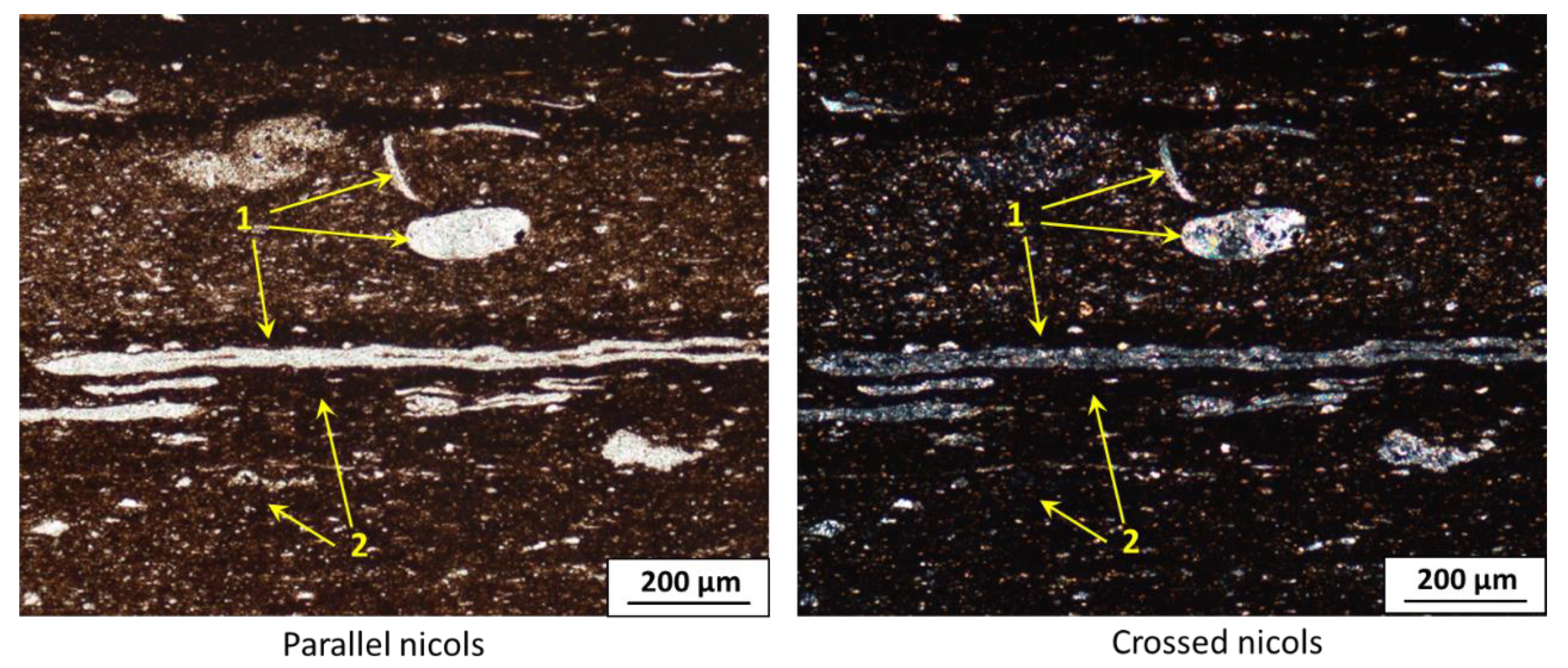

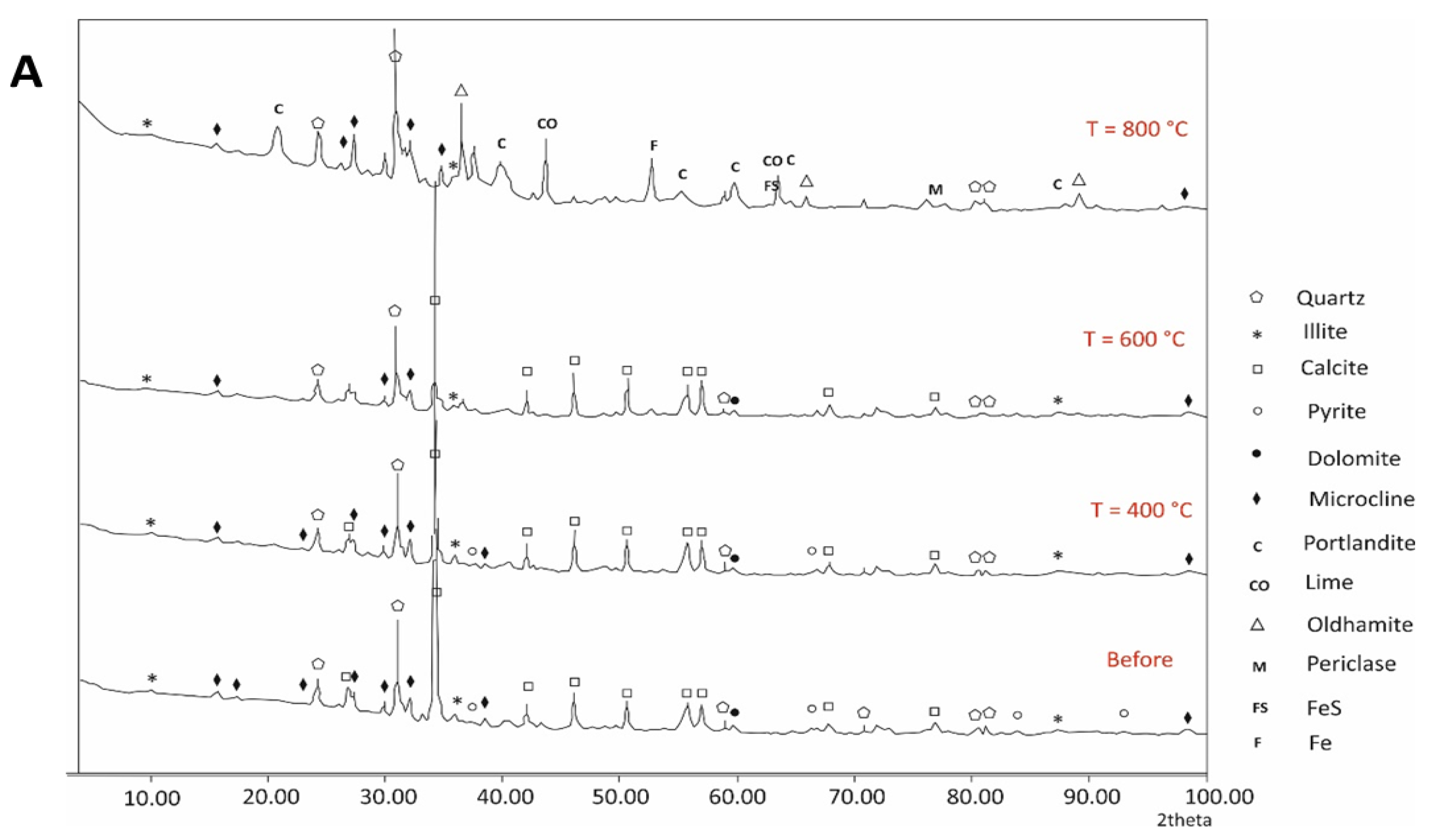
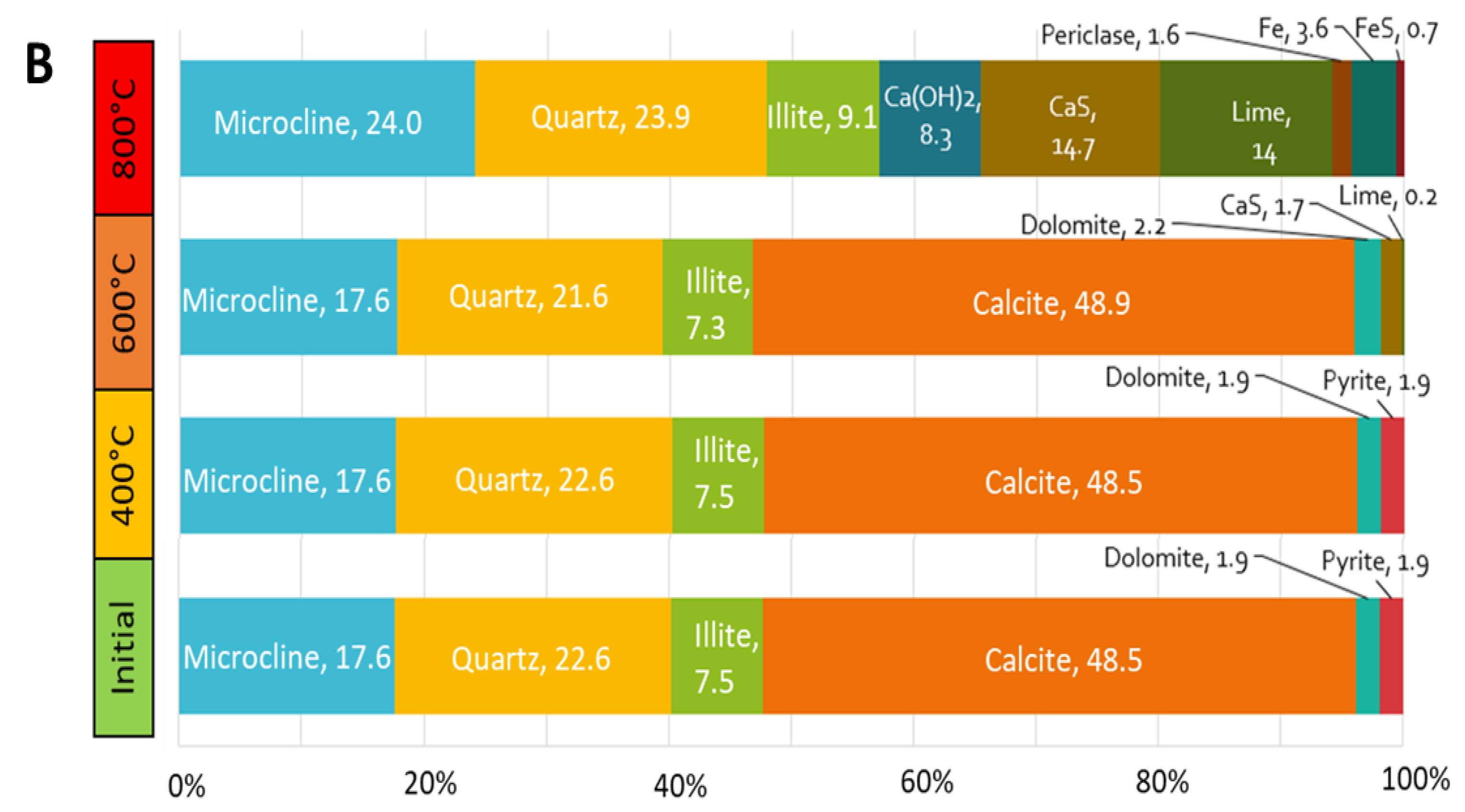
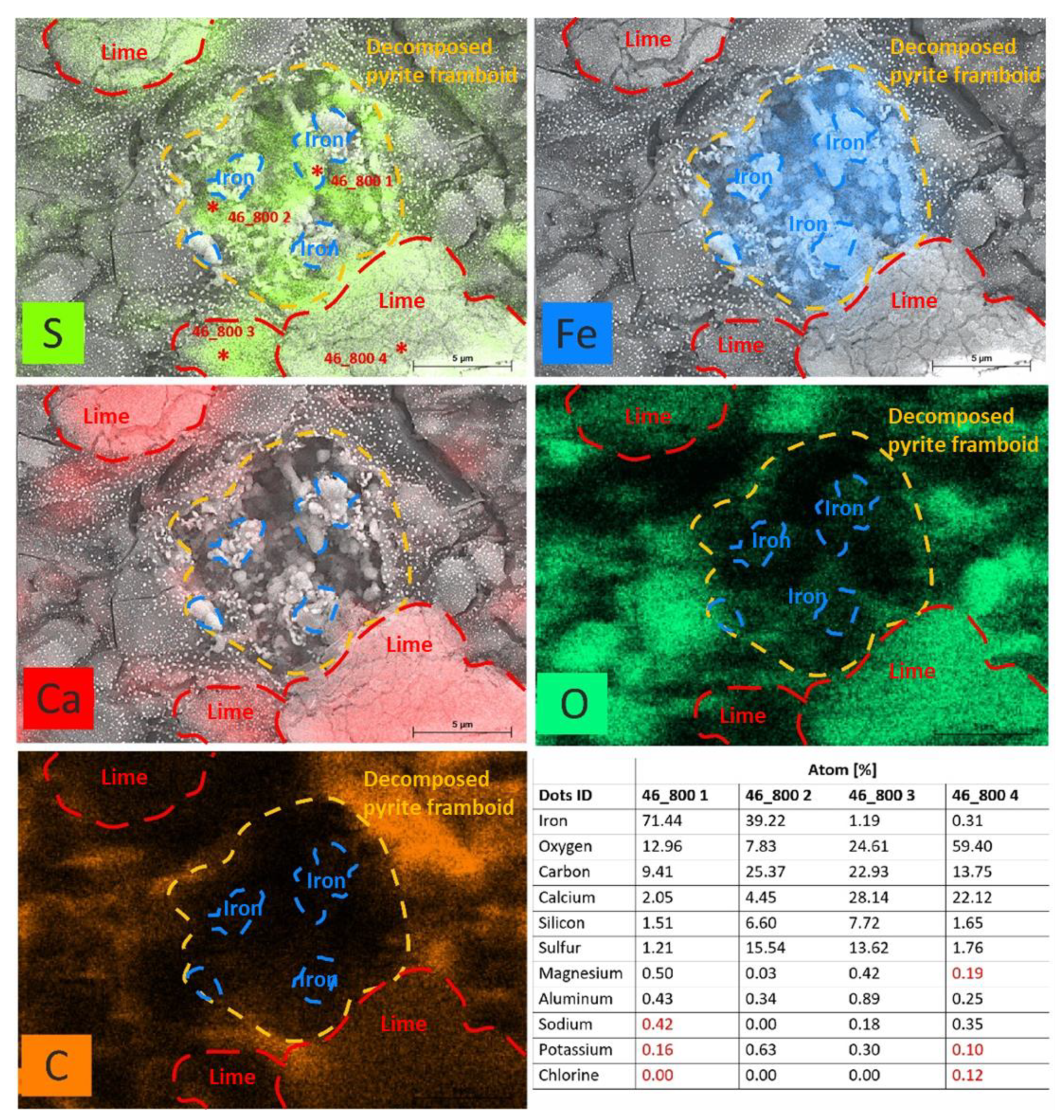
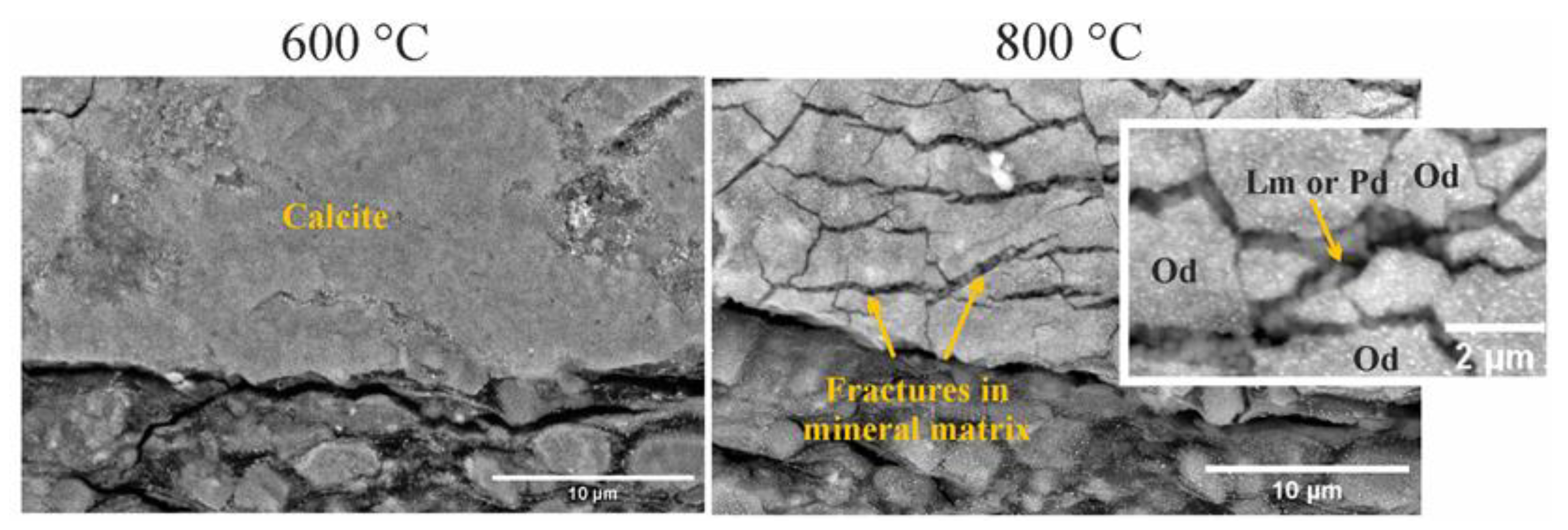
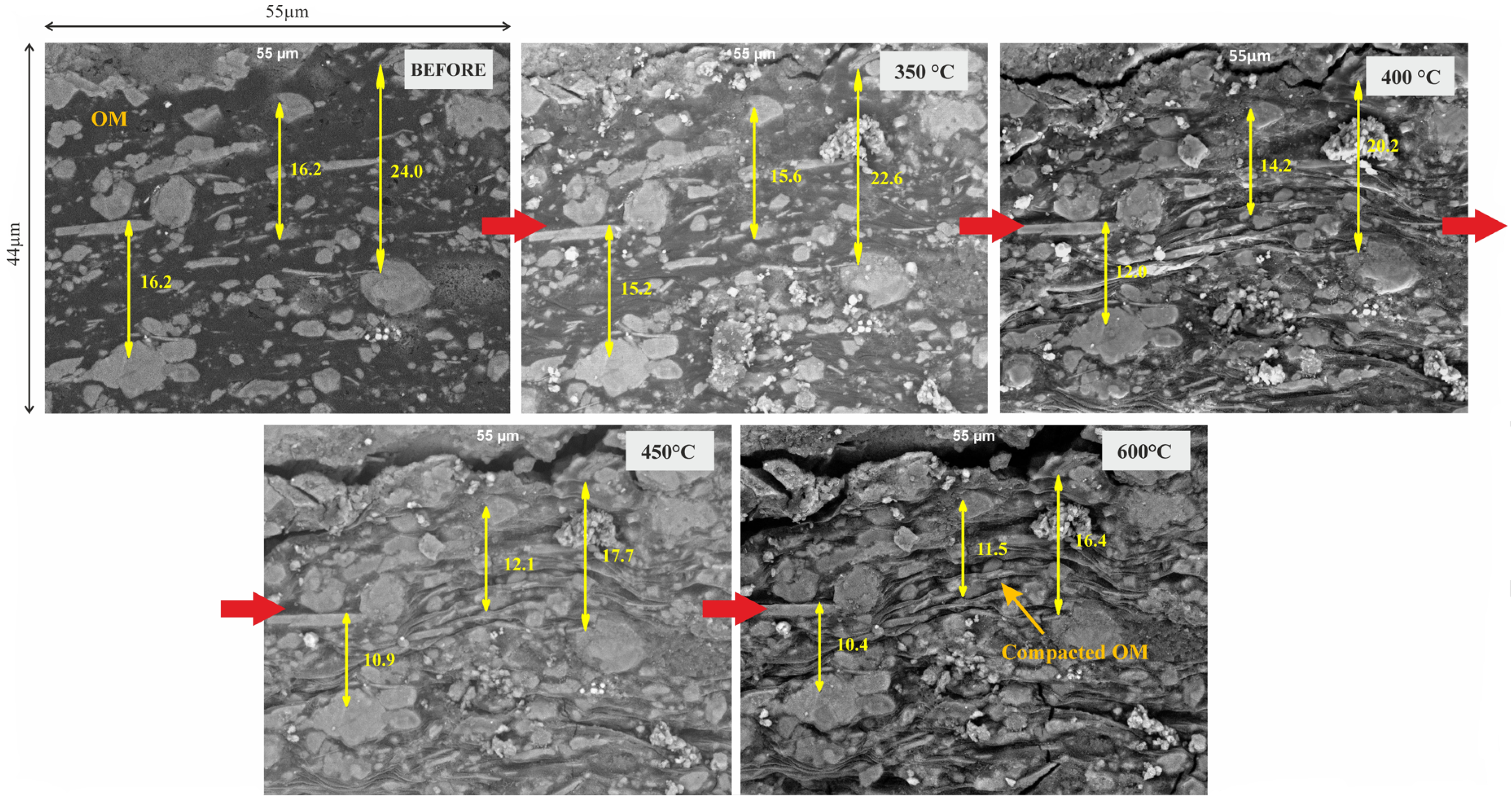


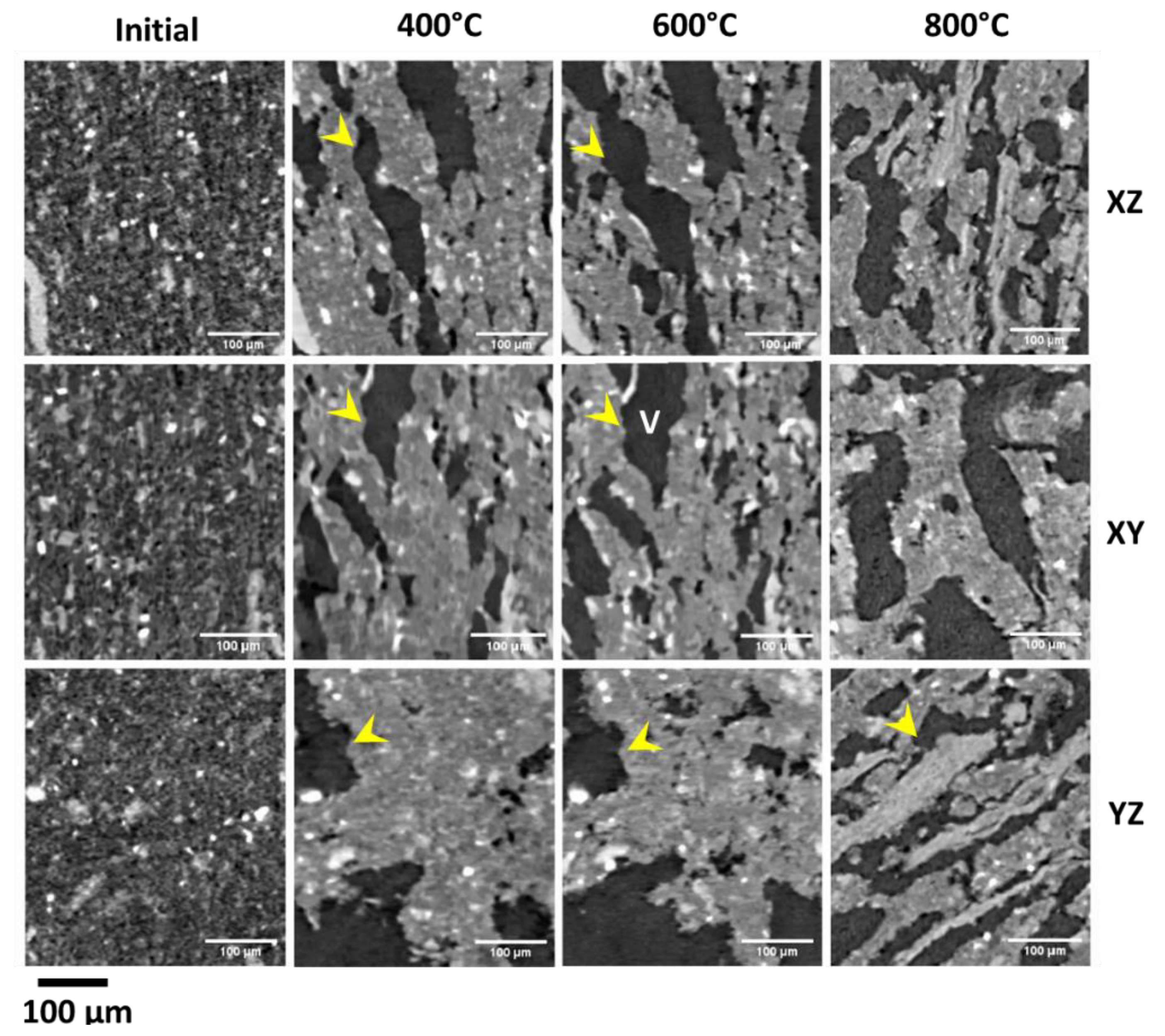

| Calcite, % | Quartz, % | Microcline, % | Illite, % | Dolomite, % | Pyrite, % |
|---|---|---|---|---|---|
| 48.5 | 22.6 | 17.6 | 7.5 | 1.9 | 1.9 |
Publisher’s Note: MDPI stays neutral with regard to jurisdictional claims in published maps and institutional affiliations. |
© 2022 by the authors. Licensee MDPI, Basel, Switzerland. This article is an open access article distributed under the terms and conditions of the Creative Commons Attribution (CC BY) license (https://creativecommons.org/licenses/by/4.0/).
Share and Cite
Karamov, T.; White, V.; Idrisova, E.; Kozlova, E.; Burukhin, A.; Morkovkin, A.; Spasennykh, M. Alterations of Carbonate Mineral Matrix and Kerogen Micro-Structure in Domanik Organic-Rich Shale during Anhydrous Pyrolysis. Minerals 2022, 12, 870. https://doi.org/10.3390/min12070870
Karamov T, White V, Idrisova E, Kozlova E, Burukhin A, Morkovkin A, Spasennykh M. Alterations of Carbonate Mineral Matrix and Kerogen Micro-Structure in Domanik Organic-Rich Shale during Anhydrous Pyrolysis. Minerals. 2022; 12(7):870. https://doi.org/10.3390/min12070870
Chicago/Turabian StyleKaramov, Tagir, Viktoria White, Elizaveta Idrisova, Elena Kozlova, Alexander Burukhin, Andrey Morkovkin, and Mikhail Spasennykh. 2022. "Alterations of Carbonate Mineral Matrix and Kerogen Micro-Structure in Domanik Organic-Rich Shale during Anhydrous Pyrolysis" Minerals 12, no. 7: 870. https://doi.org/10.3390/min12070870
APA StyleKaramov, T., White, V., Idrisova, E., Kozlova, E., Burukhin, A., Morkovkin, A., & Spasennykh, M. (2022). Alterations of Carbonate Mineral Matrix and Kerogen Micro-Structure in Domanik Organic-Rich Shale during Anhydrous Pyrolysis. Minerals, 12(7), 870. https://doi.org/10.3390/min12070870





